THEY ARE THE MOST UNLIKELY OF FRIENDS: Archy is a cockroach with the soul of a poet, and Mehitabel is an alley cat with a celebrated past — she claims she was Cleopatra in a previous life. Together, cockroach and cat are the foundation of one of the most engaging collections of light poetry to come out of the twentieth century.
“expression is the need of my soul,” declares Archy, who labored as a free-verse poet in a previous incarnation. At night, alone, he dives furiously on the keys of Don Marquis’ typewriter to describe a cockroach’s view of the world, rich with cynicism and humor. It’s difficult enough to operate the typewriter’s return bar to get a fresh line of paper; all of Archy’s dispatches are written lowercase, and without punctuation, because he is unable to hit both shift and letter keys to produce a capital letter.
“boss i am disappointed in some of your readers,” he writes, weary of having to explain the mechanics of his literary output. “… they are always interested in technical details when the main question is whether the stuff is literature or not.”
It is.
This Webpage celebrates the genius of Don Marquis, the creator of Archy and Mehitabel. Marquis was a writer for The Evening Sun in New York when, in 1916, he introduced Archy the cockroach in his daily column, The Sun Dial. For six years Archy’s prodigious output found a home in The Evening Sun (later renamed The Sun), and for four years after that in the New York Tribune (later the New York Herald Tribune). When Marquis left newspapering in 1926 he took Archy with him, to Collier’s magazine, The Saturday Evening Post and a handful of other publications. In all, he wrote nearly 500 sketches featuring Archy, Mehitabel, Pete the pup, Freddy the rat, Clarence the ghost, Warty Bliggens the toad, and assorted fleas, spiders and martians. The vast majority of the sketches were written under daily deadline pressure, but the simplicity of their style and the humanness of cockroach and cat give them timeless appeal.
The first collection of Archy’s writing, “archy and mehitabel” (1927), is still in print in paperback, and used hardbacks appear regularly in bookstores and online auctions. Other titles include “archys life of mehitabel” (1933), “archy does his part” (1935) and the omnibus volume “the lives and times of archy and mehitabel” (1940 and 1950 editions). Recent years have brought new collections, including two anthologies of long-forgotten sketches, “archyology” (1996) and “archyology ii” (1998), both edited by Jeff Adams, followed by “The Annotated Archy and Mehitabel” (2006), by Michael Sims (Penguin Classics), and “The Best of Archy and Mehitabel” (2011), part of Alfred A. Knopf’s Everyman’s Library (Pocket Poets series). Online links to books still in print are at the right.
The drawing at the top of this page and those accompanying some of these poems are by the brilliant cartoonist George Herriman, creator of the Krazy Kat comic strip. You’ll find them in all but the earliest editions of Marquis’ Archy and Mehitabel books.
Click on the paragraph above to see Don Marquis’ complete Sun Dial column from March 29, 1916, where Archy first made himself known. Following Don’s customary style, the column is a mix of news commentary, doggerel poetry and short sketches. Archy’s appearance came at a time of great public interest in the supernatural: Sherlock Holmes creator Arthur Conan Doyle had recently claimed to see fairies, and spiritualists held sway at elaborate seances. Marquis used Archy to poke fun at this latest fad, and also at free-verse poetry, which then was spreading like influenza through New York’s Greenwich Village.
This first Archy column also introduces an alley cat of questionable character. Marquis wouldn’t give a name to the cat for several months yet, but 11 years later Mehitabel’s name was slipped into the opening text when it was republished in a book, the first of many editions of the beloved “archy and mehitabel.”

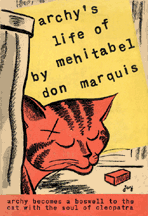

First-edition covers for the original Archy and Mehitabel books, published in 1927, 1933 and 1935
![]() Here are some of the most popular poems from “archy and mehitabel,” first published by Doubleday, Page and still in print by its successor, Penguin Random House. For additional poems and short stories, check out our Don Marquis Reading Room.
Here are some of the most popular poems from “archy and mehitabel,” first published by Doubleday, Page and still in print by its successor, Penguin Random House. For additional poems and short stories, check out our Don Marquis Reading Room.
the coming of archy
mehitabel was once cleopatra
the song of mehitabel
pity the poor spiders
mehitabel’s extensive past
the cockroach who had been to hell
archy interviews a pharaoh
freddy the rat perishes
why mehitabel jumped
certain maxims of archy
warty bliggens, the toad
the flattered lightning bug
mehitabel and her kittens
the lesson of the moth
a roach of the taverns
pete the parrot and shakespeare
Don Marquis on Archy: In the introduction to his second collection of cockroach and cat stories, “archys life of mehitabel,” Marquis comments on the enduring and amazing popularity of his lowbrow literary creatures. Marquis himself always used capital letters when writing about Archy; he explained that Archy would use capital letters, too, if he could. Read Don’s Introduction.
Archy on Don Marquis: In Marquis’ third collection of stories, “archy does his part,” Archy describes his boss’ worktable — an untidy desk littered with scraps of food and poetry. Marquis, after all, valued his poetry far above his more-mundane output. His publisher, Doubleday & Doran, printed several editions of Marquis’ serious poetry, but they never sold nearly as well as his stories about Archy and Mehitabel or about the Old Soak, another comic character who gained wide acclaim. Read the author s desk.
Shakespeare revisited: Several years ago I received a blunt e-mail nessage from a reader who asked incredulously why “pete the parrot and shakespeare” was not among the Archy poems on my Web site. It clearly was Marquis’ greatest poem, he wrote, and my site was pitiable without it. He was right, of course; Marquis’ tongue-in-cheek tale of a sad, workaday playwright is funny — and revealing. Marquis was writing about Shakespeare but talking about himself. Read pete the parrot and shakespeare.
Serious stuff: Those who might think there’s little substance to Archy’s lowercase commentary haven’t read enough of it. Archy and Mehitabel are remembered as comic characters, but often Don Marquis’ light verse was a veneer on blunt social criticism. The 19-teens through the mid-’30s were tumultuous times, witnessing a world at war, wrenching fights for labor rights and women’s suffrage, the excesses of the ’20s, and the crushing poverty of the Depression. Marquis used his newspaper and magazine columns to comment on the events of the day, good and bad, exposing a progressive heart and an increasingly cynical soul. Archy, the vers libre bard, was an eloquent mouthpiece.Read “the big bad wolf” and “what the ants are saying.”
The first drawing of Archy appeared Sept. 11, 1922, in a half-page advertisement in the New York Tribune that heralded the arrival of Don Marquis’ column
![]() Don Marquis wrote his last Archy and Mehitabel tale more than 65 years ago, but the story is far from over. Local theater groups across the United States still stage musical productions based on the stories (as my e-mail attests), and new generations have been introduced to cockroach and cat through videotape copies of the 1971 animated film “Shinbone Alley” (available online). Most of these productions trace their lineage to a 1954 collaboration between writer Joe Darion and composer George Kleinsinger, who reworked 20 years of Marquis sketches into light dialog and songs.
Don Marquis wrote his last Archy and Mehitabel tale more than 65 years ago, but the story is far from over. Local theater groups across the United States still stage musical productions based on the stories (as my e-mail attests), and new generations have been introduced to cockroach and cat through videotape copies of the 1971 animated film “Shinbone Alley” (available online). Most of these productions trace their lineage to a 1954 collaboration between writer Joe Darion and composer George Kleinsinger, who reworked 20 years of Marquis sketches into light dialog and songs.
Darion and Kleinsinger first presented their musical, “Archy and Mehitabel,” at New York’s Town Hall in December 1954 with tenor Jonathan Anderson as Archy and soprano Mignon Dunn as Mehitabel. At about the same time they produced a marvelous LP record, “archy and mehitabel: a back-alley opera,” that featured the voices of Carol Channing as Mehitabel and Eddie Bracken as Archy, with an additional, spoken-word performance by David Wayne titled “echoes of archy” (Columbia ML 4963). Theatre Arts magazine said of the record: “Bracken is every inch a cockroach, and Miss Channing is perfection as the female feline who chose Shinbone Alley over the comforts of domestication.” The record can occasionally be found today in used-record stores and online auctions, as can a two-record, 45-rpm version (Columbia A-1107).
Two years later Darion and Kleinsinger reworked “archy and mehitabel” with the help of a young humor writer who would go on to achieve fame in his own right, Mel Brooks. They renamed the production “Shinbone Alley” and presented it as a full-scale Broadway musical in April 1957, with Bracken again playing Archy and Eartha Kitt as a raucus Mehitabel. Brooks Atkinson, writing in the New York Times, praised the effort — particularly Kleinsinger’s engaging score — but said the writers erred by “taking the line of least resistance on the musical stage” and portraying Archy as being in love with Mehitabel. “A cat and a cockroach do not make attractive lovers,” he wrote. “Nor does a romantic attachment have anything like the distinction of archy’s sardonic attitude toward mehitabel in the original poems. Although archy was fascinated by her, he disapproved of her wanton behavior.” Atkinson concluded: “There is a lot of fresh and amusing stuff in ‘Shinbone Alley,’ particularly notable in a stale season like this one. But the basic problem of how to make a theatre piece out of a book of random verse has not been solved.”
“Shinbone Alley” saw only 49 performances before it closed, but several of its songs went on to find a permanent home in the repertoire of both Carol Channing and Eartha Kitt, and the Broadway cast recording was released as an LP in 1957 (Mastertone 1251) and on CD in 1993 (Legend 6009/6010). “Shinbone Alley” also appeared on television in 1960, with Tammy Grimes playing the role of Mehitabel, and the performance was later released on an LP with another recent Brodway show, “Shangri-La” (Sound of Broadway 300/1).
Darion and Kleinsinger tried one last time to bring new life to Archy and Mehitabel with the 1971 feature-length animated film “Shinbone Alley.” Directed by John Wilson and once again joining Carol Channing and Eddie Bracken in the lead roles, the film also featured the voices of John Carradine as an aging “theater cat” and Alan Reed Sr. (Fred Flintstone) as Mehitabel’s tomcat boyfriend. It’s an enjoyable movie, with tuneful music and animation unlike the standard Disney fare of that time, but like the Broadway musical it’s still miscast: It’s a movie intended for children but written for adults, and its premise is a love affair that is unimagineable.
New York Times reviewer Vincent Canby panned the film, but his review should be cherished for its dead-on description of the Mehitabel brought to life by Don Marquis (if not, alas, by the filmmakers): “a toujours gai old dame with the soul of Cleopatra, the airs of Emma Bovary, the artistic longings of Isadora Duncan, the hangovers of Dorothy Parker’s Big Blonde, and the sexual resolve of “Trash’s” Holly Woodlawn.”
Originally named “archy and mehitabel” when released as an LP in 1954, the words and music were reworked as “Shinbone Alley” in a 1957 Broadway musical and a 1971 animated movie. Today, the production is available to theater groups as “Archy & Mehitabel.”
![]() In 1986, Marquis fan Jeff Adams came along to add a few more pages to the story. Adams had acquired the contents of a locked trunk from a Brooklyn warehouse. The long-forgotten trunk had belonged to one of Marquis’ sisters, and it held a treasure of Marquis writings and clippings. Four Archy sketches that had not been seen since their publication a half-century earlier were printed in the October 1986 issue of The Atlantic Monthly (with illustrations by Edward Gorey), and in 1996 Adams collected 41 of the sketches in a book, “archyology: the long lost tales of archy and mehitabel,” which received warm applause from book reviewers and readers. He followed it in 1998 with “archyology ii: the final dig.” Illustrations in both books were by Ed Frascino. Them in 2006, author Michael Sims did a heroic job of annotating more than 200 original Archy sketches, and for the first time presented them in chronological order, in “The Annotated Archy and Mehitabel” (Penguin Classics), followed in 2011 by “The Best of Archy and Mehitabel,” essentially an abridged version of “the lives and times of archy and mehitabel” published by Alfred A. Knopf’s Everyman’s Library (Pocket Poets series).
In 1986, Marquis fan Jeff Adams came along to add a few more pages to the story. Adams had acquired the contents of a locked trunk from a Brooklyn warehouse. The long-forgotten trunk had belonged to one of Marquis’ sisters, and it held a treasure of Marquis writings and clippings. Four Archy sketches that had not been seen since their publication a half-century earlier were printed in the October 1986 issue of The Atlantic Monthly (with illustrations by Edward Gorey), and in 1996 Adams collected 41 of the sketches in a book, “archyology: the long lost tales of archy and mehitabel,” which received warm applause from book reviewers and readers. He followed it in 1998 with “archyology ii: the final dig.” Illustrations in both books were by Ed Frascino. Them in 2006, author Michael Sims did a heroic job of annotating more than 200 original Archy sketches, and for the first time presented them in chronological order, in “The Annotated Archy and Mehitabel” (Penguin Classics), followed in 2011 by “The Best of Archy and Mehitabel,” essentially an abridged version of “the lives and times of archy and mehitabel” published by Alfred A. Knopf’s Everyman’s Library (Pocket Poets series).
Edward Gorey’s Archy stands between the two newest compilations of Don Marquis’ work, edited by Jeff Adams and published in 1996 and 1998.
![]() In recent years, Archy tales have surfaced in electronic media with the nimbleness of, well, cockroaches. In addition to this Web page, Archy has been featured on Jim Ennes’ Don Marquis Web site for 20 years now, and composer Robert Arnold Hall recently produced a digital video about one of Marquis’ Archy sketches, as well as a musical theater piece. More than a dozen Web sites include a favorite Archy poem, and Archy epigrams are scattered everywhere.
In recent years, Archy tales have surfaced in electronic media with the nimbleness of, well, cockroaches. In addition to this Web page, Archy has been featured on Jim Ennes’ Don Marquis Web site for 20 years now, and composer Robert Arnold Hall recently produced a digital video about one of Marquis’ Archy sketches, as well as a musical theater piece. More than a dozen Web sites include a favorite Archy poem, and Archy epigrams are scattered everywhere.
Offline, local theater groups still regularly perform “Archy & Mehitabel,” based on Darion and Kleinsinger’s Broadway musical, and a number of individuals and theatrical groups have tried their own hand at interpreting Marquis’ stories. In 1989 composer Andrew Stiller completed a work for soprano and violin titled “mehitabel dances with boreas,” which he describes as a “commentary on the homelessness crisis.” In the work, Stiller says, “Mehitabel the cat snaps her teeth, gasps and yowls as she dances all night in an alley to keep from freezing to death, accompanied by the traditional fiddle of the danse macabre.” Currently, Gale McNeeley, an actor and theater instructor in California, has a one-man show based on the original Archy and Mehitabel newspaper columns. You can contact Gale at this address.
To borrow from Mehitabel, “There’s a dance in the old dame yet.”

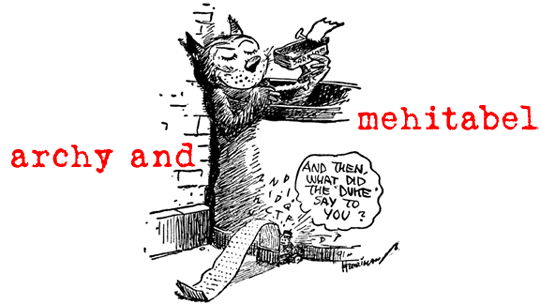



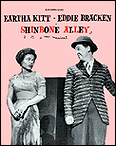


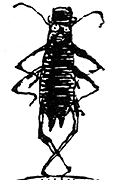
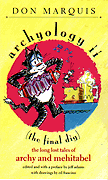

Pingback: Archy the Cockroach: Prescient on Climate Change in 1935 « Climate Denial Crock of the Week
Pingback: Tuesday Poem – the lesson of the moth (Don Marquis) « Elizabeth Welsh
Pingback: 5 Things to Do When the End of the Year is Too Far Away | 7sistershomeschool.com
Pingback: the cockroach who had been to hell by Don Marquis | russellboyle
Pingback: poetry | Pearltrees
Pingback: archy got no respect | Rturpin's Blog
Pingback: the lesson of the moth by Don Marquis | russellboyle
Pingback: Archy and Mehitabel -a rediscovery! | Clint Spoon's
Pingback: The Book of Frog: A Way of Discussing the World - the Town Crierthe Town Crier
Pingback: Archy and Mehitabel | Scripturient: Blog & Commentary
Pingback: A Dance or Two | A Song Per Day
Pingback: don marquis – certain maxims of archy | fleurmach
Pingback: Philip Pullman’s Jeffrey | educating alice
Pingback: Mastering the voice | Dave's diaries
Pingback: Mindfulness–Days Of The Week–Unabridged | «double vision»
Pingback: Mindfulness–Days Of The Week–Condensed | «double vision»
Pingback: Mindfulness–Days Of The Week–Condensed | «double vision»
Pingback: In review: The Talisker Players’ Bestiary | Schmopera
Pingback: Birthday, Schmirthday. | The San Francisco Scene--Seen!
Pingback: The bad and the ugly | Antilles Adventure
Pingback: Giant typewriter sculpture coming to the Greenway | Local National News